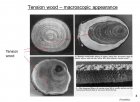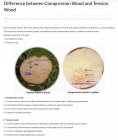- Joined
- Apr 27, 2004
- Messages
- 9,164
- Likes
- 5,769
- Location
- Lakeland, Florida
- Website
- www.hockenberywoodturning.com
I realized how little I knew about the accepted terminology for wood that grew under stress and thought it worth sharing some research.
Reaction wood has two forms: tension wood and compression wood. It is wood that grows to fight gravity in a limb or leaning tree.
Tension wood grows on the topside and holds up the tree or limb
Compression wood grows on the bottom side and pushes up the limb or tree.
Contrary to logical thought you don’t get both on either side of a leaning tree. Hardwoods make tension wood and conifers make compression wood.
As wood turners we need to be aware vessel walls can move when tension wood is hollowed.
Some woodturners avoid limbs because of the tension wood.
I use limbs often in making natural edge bowls and hollowforms.



Reaction wood has two forms: tension wood and compression wood. It is wood that grows to fight gravity in a limb or leaning tree.
Tension wood grows on the topside and holds up the tree or limb
Compression wood grows on the bottom side and pushes up the limb or tree.
Contrary to logical thought you don’t get both on either side of a leaning tree. Hardwoods make tension wood and conifers make compression wood.
As wood turners we need to be aware vessel walls can move when tension wood is hollowed.
Some woodturners avoid limbs because of the tension wood.
I use limbs often in making natural edge bowls and hollowforms.



